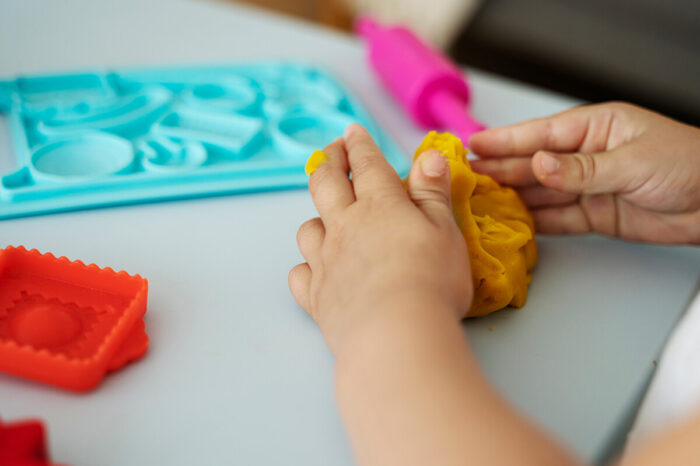
Article author:
Anita Vayakanti – a child and perinatal psychologist, art therapist, Master in Health and Development Psychology.
When I read everyday news, my first reaction is to turn into a turtle and hide my head in a shell. After a couple of minutes I come to my senses, remember that I have a blog with useful information for everyone, parents who follow my practical advice and a profession which helps others.
There was always a lot of useful material in my profile, and since the end of the spring 2022 I have tried to publish as many supportive articles, fairy tales, exercises and information as possible. All this is available on my Instagram instagram.com/anita_prof. Please check, read and save helpful information.
Today I want to share with you exercises that you can do on your own with children. Exercises aimed at relieving tension, stress, muscle clamps, preventing neurosis and much more.
All of today’s techniques/ exercises will be playdough related. And now I will explain why. Playdough, like clay and dough, are materials that are very receptive to the feelings of a child. Gradually kneading a piece, a pleasant warmth spreads through the hands, and it is very noticeable how the children relax and gain a sense of comfort.
Also, in the shoulder girdle, hands and fingers, a large number of muscle clamps are often concentrated, which are often a sign of psychological discomfort. Working with playdough includes muscles and helps to relieve excessive tension by gradually squeezing and unclenching the hands. Therefore, I strongly recommend using a hard type of playdough.
Sculpting, like drawing, is a guide to the unconscious of a child (and an adult), this is one of the most effective ways of interacting with the inner world.
Below, I will share some effective exercises and even small fairy tales (introductory ones) that you can use with your children. Children are our future, the generation that will change this world. So let’s help their mind and their inner world to come to calmness and confidence, no matter what.
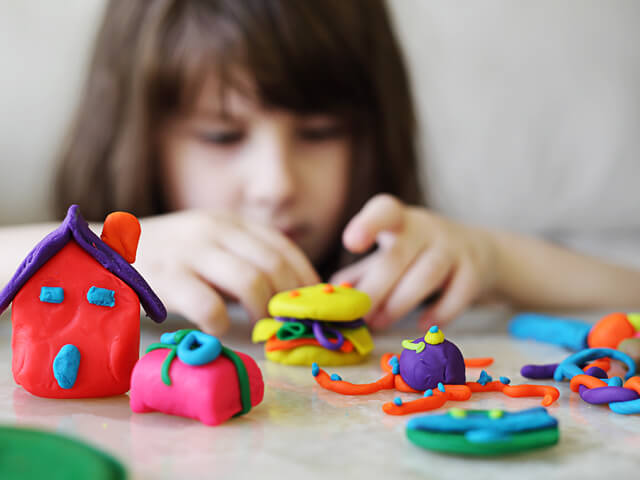 TECHNIQUE “MODELING FEAR”
TECHNIQUE “MODELING FEAR”
Goal: transformation of negative emotions into positive ones.
Age: 3-18 years and older.
Stage 1: The child selects any piece of playdough or other plastic material and starts shaping it with his eyes closed, discovering his/ her problems, fears, blockages, resentments, etc.
Time is given to the child as much as he/she needs, approximately 5-15 minutes for the child to relax.
Stage 2: With open eyes, the child sculpts his “fears”.
Then you can play with the received fears, for example, scare each other. After that, the molded figures are destroyed (they can be torn, flattened, trampled).
Stage 3: From the same piece of playdough we sculpt something good, kind, beautiful.
Issues for discussion:
– What did you make? Tell us more about your work.
– What feelings did you have while making it?
– What method of escaping from your fear did you choose? What is this fear now?
– What feelings did you have during the “escape” from your fear?
– Has your attitude towards your fear changed now?
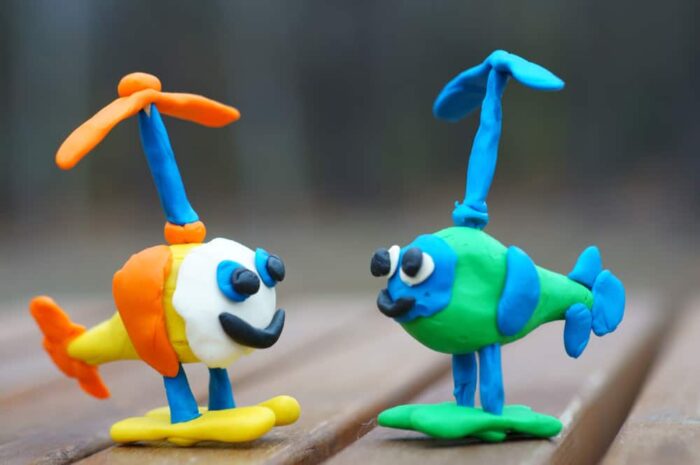 TECHNIQUE “TALISMAN”
TECHNIQUE “TALISMAN”
Goal: To create a sense of safety and security in the present. Obtaining a powerful resource for gaining confidence in your future.
Age: 5+ and older.
Step 1: Please remember a fairy tale in which there is some kind of magical object that gives the main character some kind of ability, power that helps or protects him. Would you like to have such an object? What could it be? What does it look like? What is its function, purpose, power?
Step 2: Blind it!
The child makes a talisman using multi-colored playdough, then tells what it protects from or what allows to achieve, overcome.
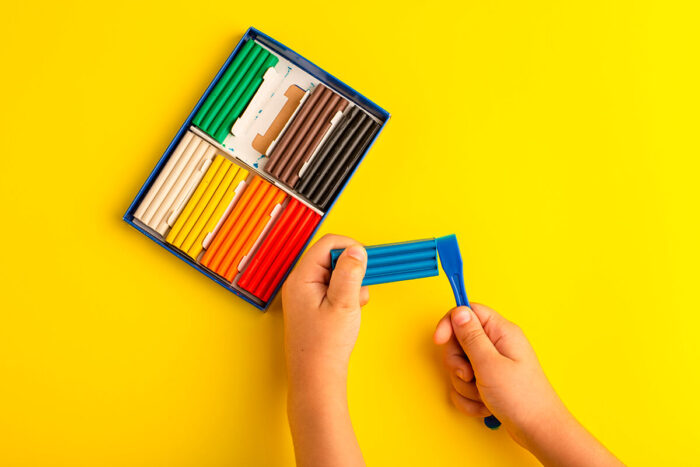 TALE EXERCISE “COLOR PLAYDOUGH”
TALE EXERCISE “COLOR PLAYDOUGH”
Age: older preschoolers and younger students
Once upon a time there were ten multi-colored pieces of playdough in an old cardboard box: red, orange, yellow, green, blue, purple, brown, white and black. They lived together, always took up work together, created beautiful, bright crafts and never quarreled.
But one day the Red Piece of playdough said: “I am the most important, because I am the brightest! I can create a red fire, a red sun, but you can’t!”
“But I can create a yellow sun, a lemon, sea sand, but you cannot! So I’m in charge!” – objected the Yellow Piece.
“No,” said Green Piece. – I’m the boss! Only I can make green grass, a grasshopper, a crocodile, but you can’t!”
“And I can blind the black night, and I can also darken everything that you create and there will be one continuous blackness!” shouted the Black Piece loudly.
Pieces of playdough argued for a long time. Everyone said that he was the most important. They decided to leave their home – an old cardboard box – and go wandering around the world. Everyone went in his direction in splendid isolation.
Red Piece met a bright swallowtail butterfly. He wanted to mold it, but he got a red butterfly, not at all like a real one. The Red Piece was upset.
Yellow saw a magical flower on his – a seven-colored flower. He tried to recreate it, but he got a yellow flower on a yellow stem with yellow leaves, not at all like a real one. The Yellow Piece cried.
Green Piece got a bright ripe strawberry on his way.. He began to mold it, and his strawberry came out completely unripe and green. Saddened Green Piece.
And for Black Piece everything was black as night when he tried to mold it. Our heroes wandered alone for a long time. And then one day, after the rain, they all came out at the same time to a wide forest clearing. The playdough brothers were very happy with each other, began to hug and rejoice that they were together again.
Suddenly the clouds dissipated, a bright sun came out, the emerald grass turned green, the flowers were full of light, bright butterflies fluttered, and a multi-colored rainbow-arc spread like a yoke in the blue sky. The playdough pieces rejoiced and, without thinking twice, they set to work together. Everyone found their own work, no one was left behind. Soon they got a bright fabulous multi-colored craft that looked like it was alive. Pieces of playdough looked at it and gasped with admiration. And the sun in the sky smiled and said affectionately: “You see how important it is to stick together! Each of you is good in your own way, but only together you can make wonders!”
Task for the child: create something using all the colors of playdough that you have in the house.
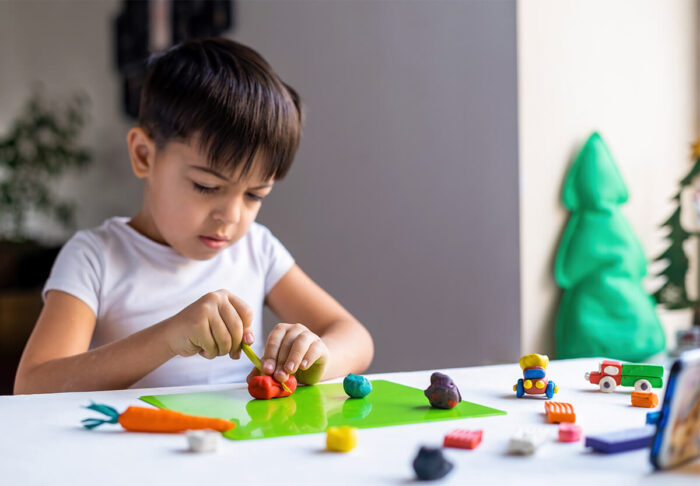 EXERCISE “MULTI-COLORED LIGHTS”
EXERCISE “MULTI-COLORED LIGHTS”
Goal: development of fine motor skills of the hands, removal of muscle tension from the hands and fingers, identification of the current emotional state of the child.
Age: 5-8 years old
Exercise progress:
The child is offered a palette with playdough colors. Instructions are given: “Imagine that you and I are going to decorate a Christmas tree. Please, take one ball of playdough of each color and arrange them on a piece of paper in the form of small lights. Choose colors in descending order of beauty (to your opinion): first the most beautiful, and in the end the most unpleasant.
After completion, a conversation is held with the child about the selected colors and their sequence.
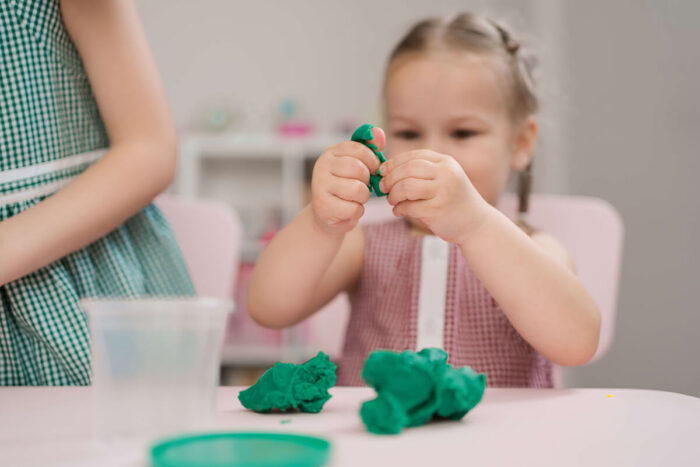 EXERCISE “DESTROY AND CREATE”
EXERCISE “DESTROY AND CREATE”
Goal: stress relief, expression of accumulated emotions, prevention of aggressive behavior.
Age: 5+
Ask the child to represent the “problem” (what worries him/ her) as a character and mold it out of playdough. After the character is created, invite the child to “destroy this problem.” Flatten, crumple, roll, press, etc. – thus, there is a kind of illness on the hero of negative experiences and a decrease in the severity of experiences. Next, invite the child to create a new symbol from the resulting mass, something good and inspiring. Create a kind of friendly friend. Put a new symbol in the freezer for a while, so that the playdough becomes hard representing that the friend becomes reliable.
Big hug to you and I hope that my articles and materials resonate and support those who need it now.
Take care of yourself. Take care of your children.
Yours, Anita Vayakanti
